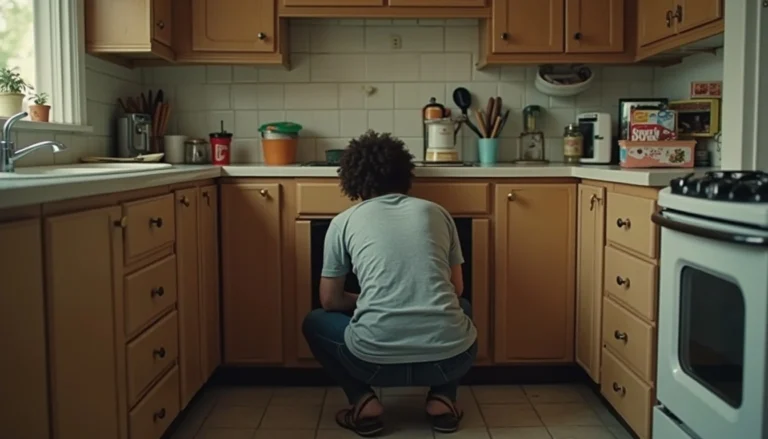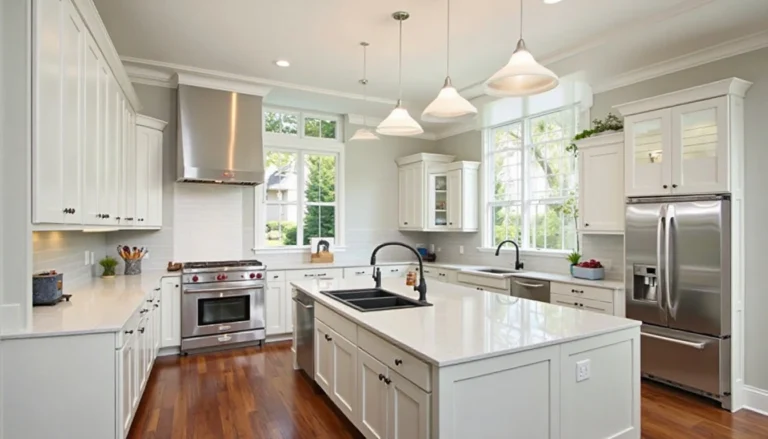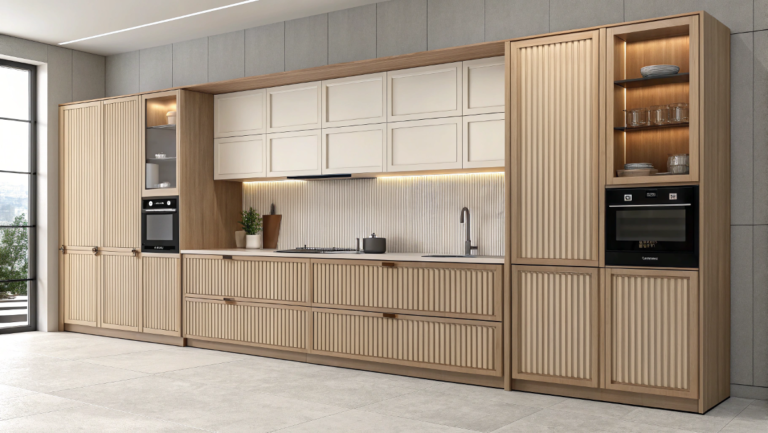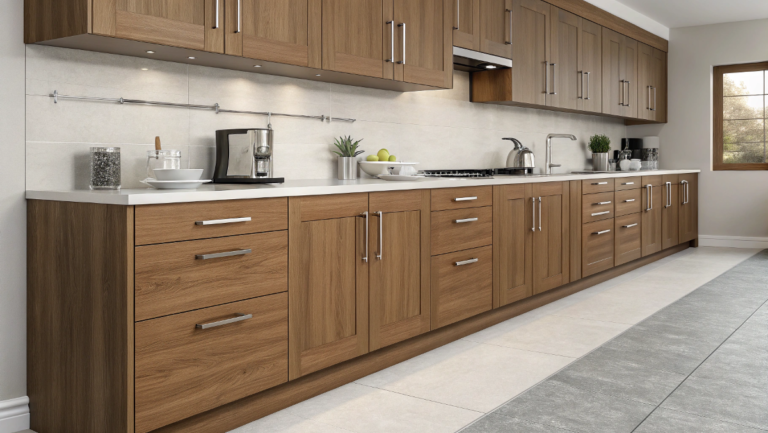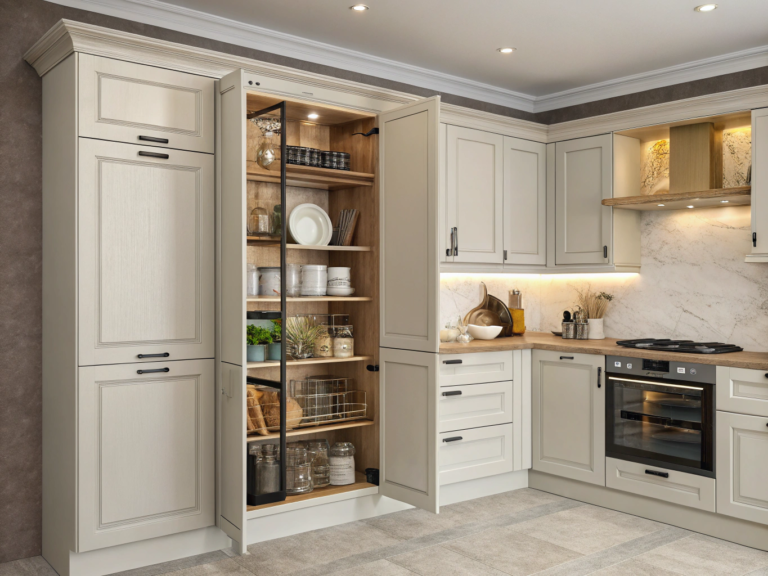pantry cabinet depth standard or best pantry cabinet depth
Tall cabinets are like the unsung heroes of the kitchen. They don’t get the spotlight like islands or fancy fixtures, but they quietly store everything: brooms, snacks, dog food, that giant roasting pan you only use once a year. And yet, one of the most overlooked details is this: pantry cabinet depth.
When I redid my grandma’s kitchen, we kept her old slim 12-inch pantry wedged next to the fridge. It didn’t seem like much, but it held an entire winter’s worth of canned tomatoes. Since then, I’ve realized that depth isn’t just about space, it’s about how you cook, what you store, and whether you want it visible or tucked away.
So let’s unpack it. In this guide, we’ll look at the two most common pantry cabinet depths, 12 and 24, and help you figure out which one fits your kitchen, your stuff, and your daily flow.
Standard Sizes. 12 or 24 Depth
When it comes to pantry cabinets, there are two main camps: the slim 12-inch deep pantry and the full-sized 24-inch version. Each has its strengths, and honestly, your choice should come down to what you’re storing and how much digging you want to do.
12, Pantry Cabinets. Shallow, Smart, Surprisingly Spacious
These are great for small kitchens, tight corners, or anyone who hates losing things in the back of shelves. With a 12″ depth, you can actually see what you’ve got at a glance. No moving five cereal boxes to find the oatmeal. It’s perfect for cans, jars, spices — things that get lost in deeper shelves.
I’ve had one of these in every kitchen I’ve lived in, and I still swear by them for day-to-day use. Sure, you won’t fit your stand mixer in there, but for visibility and quick grabs? They’re unbeatable.
24″ Pantry Cabinets: Deep Storage for Deep Kitchens
These are more like utility units, great if you’ve got the space and need to store bulk items, small appliances, or cleaning supplies. You can fit bins, baskets, and even tall containers without a problem. But the catch? Things get buried fast if you don’t use pull-outs or organizers.
A friend of mine has a gorgeous 24″ pantry that holds everything from paper towels to her air fryer. It’s a lifesaver, but without labeled baskets, she admits it’s kind of a black hole.
Is there a standard pantry cabinet depth I should stick with?
Not exactly. 12″ is ideal for visibility and small-item storage, while 24″ offers more room but requires better organization. If you can, try combining both in different zones.
How to Choose Based on Storage Goals

Here’s the thing: pantry cabinet depth isn’t just about square footage. It’s about how you use your kitchen. Before you decide on 12″ or 24″, take a step back and ask: What am I trying to store, and how often do I need to grab it?
If You Want Quick Access & Visibility
Go for the 12″. These are perfect if your pantry is filled with day-to-day essentials, spices, pasta, snacks, and sauces. You’ll see everything at a single glance, and nothing gets pushed to the back and forgotten. If you’re the kind of cook who likes to scan and grab without digging, this is your zone.
Plus, 12″ pantries are way easier to keep tidy. There’s no temptation to double-stack cans or shove in oversized items that don’t belong. Everything has a home, and it stays there.
If You Need Volume & Flexibility
Choose 24″, but prep for a little extra effort. These deep cabinets can handle the big stuff: mixers, blenders, rice cookers, paper towel stockpiles. But without organizers like pull-out shelves or stacking bins, they can get chaotic fast.
I once helped a neighbor convert a tall 24″ pantry into a cleaning closet, complete with hooks for the mop, a vacuum dock, and slide-out trays for rags and cleaners. It worked beautifully, but only because she designed the inside to match her workflow.
Can I install pull-outs in both 12″ and 24″ pantry cabinets?
Yes, though pull-outs shine most in deeper cabinets (18″+). In 12″ units, open shelving often works just fine. But if you’re storing heavy or oddly-shaped items, even a shallow pull-out can make a big difference.
Matching Tall Units to Base & Wall Cabinets

Tall pantry cabinets are bold by nature; they reach from floor to ceiling, so they will stand out. But whether they look beautifully integrated or awkwardly tacked on? That comes down to how well they coordinate with your base and wall cabinets, especially in terms of depth.
If your pantry is 24″ deep, it’s going to align nicely with standard base cabinets, giving you a flush, built-in look. This is a common strategy when placing tall cabinets beside fridges or wall ovens, where depth matching is key to keeping everything feeling clean and cohesive.
But what if your wall cabinets are still the standard 12″? That’s fine, most kitchens are designed that way. The trick is to create a visual transition. This can mean using crown molding to bridge the height difference, adding a filler panel for smoother lines, or anchoring the tall cabinet at the end of a run where depth shifts feel natural.
I’ve also seen some clever tricks like recessing the pantry slightly or using contrasting colors or finishes to intentionally set it apart, kind of like saying, “Yes, it’s different, and that’s the point.”
Should my pantry cabinet always match the depth of nearby cabinets?
Not always. If it’s next to your fridge or oven, match the depth. But if it’s on a standalone wall or at the end of a cabinet run, playing with depth can add character, as long as it looks intentional.
Design Use Cases: Small Kitchens, Utility Rooms, Hidden Storage

Tall pantry cabinets aren’t just for big, shiny kitchens in design magazines. They’re often most useful in tight spaces; you just have to get a little creative with where and how you use them.
In Small Kitchens
Slim 12″ pantries tucked into a corner or beside the fridge can make a huge difference. They give you vertical storage without eating up floor space. I once saw a galley kitchen where the entire dry goods pantry was a single 12″ wide, 84″ tall cabinet, and it held everything, from snacks to baking supplies.
If your kitchen layout won’t fit a full-size pantry, consider using two smaller ones, flanking a window, framing a nook, or balancing either end of a wall run. The symmetry feels intentional, and the storage is surprisingly generous.
In Utility or Laundry Rooms:
24″ deep, tall cabinets are fantastic for brooms, cleaning products, pet supplies, even hiding a mini vacuum or charging dock. You can outfit them with hooks, bins, even a shelf for folded towels or extra paper goods. These are the kinds of details that make a home feel dialed in.
For Hidden Storage:
Want to hide a microwave, coffee station, or even a full bar setup? A 24″ deep, tall unit with interior outlets can do the job. Close the doors, and everything disappears. It’s like a grown-up version of playing house, but with better lighting.
Can I put a pantry cabinet outside the kitchen, like in a hallway or mudroom?
Absolutely. As long as it fits the space and serves a purpose (extra storage, overflow, cleaning supplies), a pantry cabinet can live anywhere, not just beside your fridge.
Final Thoughts: Depth That Works for the Way You Live
When you’re planning a pantry cabinet, it’s easy to get caught up in dimensions, 12″ vs 24″, shelf heights, and pull-out options. But at the end of the day, pantry cabinet depth should serve you, not the other way around.
If you like knowing where everything is, hate digging, and want to keep your kitchen feeling open and tidy? Stick with 12″. If you’ve got bulk items, awkward appliances, or you’re trying to make the most of a utility zone? Go 24″, just be ready to organize it well.
Either way, depth isn’t about more space; it’s about usable space. The right pantry cabinet should make your life easier, your mornings smoother, and your kitchen feel a little more like home.
Useful Resources


